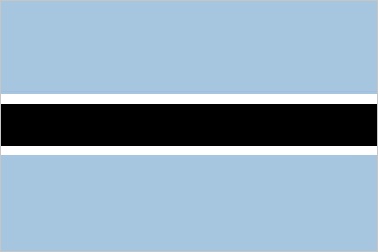Botswana, flag of
Flag History

national flag consisting of a light blue field (background) with central white-black-white stripes. Its width-to-length ratio is 2 to 3.
The Tswana people of southern Africa were divided by political boundaries drawn by European settlers in the late 19th century. Some lived to the south of the new border in (British) Cape Colony and thus came under its jurisdiction, while those to the north formed a separate entity under British control, the Bechuanaland Protectorate. In 1910 the Union of South Africa was formed by Cape Colony, Natal, and the former Afrikaner republics of the Transvaal and Orange Free State. For many years the white-dominated government of South Africa agitated for the annexation of Bechuanaland and two other small territories, today the independent nations of Lesotho and Swaziland. Instead, Britain granted independence to Bechuanaland in 1966 as the Republic of Botswana.
Bechuanaland had no distinctive national symbols of its own prior to independence. The national flag, adopted in 1966, symbolically contrasted with the flag of neighbouring South Africa, where the policies of apartheid (racial segregation and the subjugation of nonwhites) were in effect. Botswana proclaimed in the flag's central black stripe and its white bordering stripes a belief in racial cooperation and equality. The light blue background of the flag is associated with the sky and with water, a scarce and precious commodity in the vast Kalahari desert. The importance of water is also reflected in the motto that appears in the national coat of arms: it is a single word, “Pula,” connoting rain, hope, and confidence in the future.
- Parliament Act of 1911
- Parliament, Admonition to
- parliamentary procedure
- Parliament-Funkadelic
- Parliament, Houses of
- Parléř, Petr
- Parma
- Parma and Piacenza, Duchy of
- Parmelia
- Parmenides
- Parmenio
- Parmentier, André
- Parmesan
- Parmigianino
- Parnassia
- Parnassian
- parnassian butterfly
- Parnassus, Mount
- Parnaíba
- Parnaíba River
- Parnell, Charles Stewart
- Parnell, Thomas
- Parni
- Parnicki, Teodor
- Paro